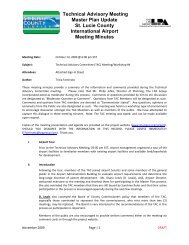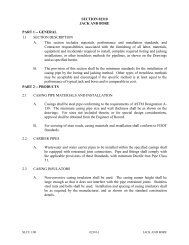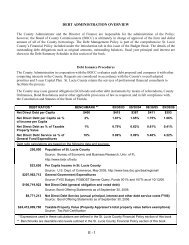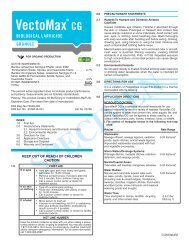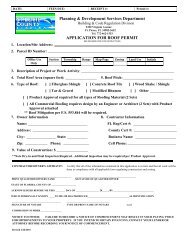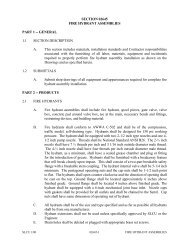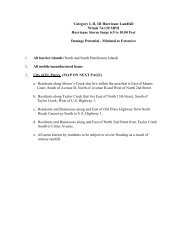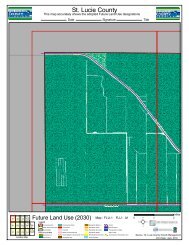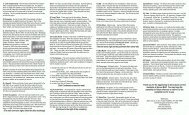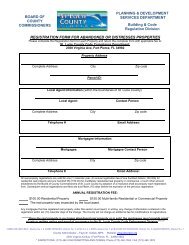2010 Artificial Reef Monitoring Report - St. Lucie County
2010 Artificial Reef Monitoring Report - St. Lucie County
2010 Artificial Reef Monitoring Report - St. Lucie County
Create successful ePaper yourself
Turn your PDF publications into a flip-book with our unique Google optimized e-Paper software.
ST. LUCIE COUNTY ARTIFICIAL REEF MONITORING November <strong>2010</strong><br />
6 Summaries<br />
6.1 DMC Barge/500 Ton Pile <strong>Reef</strong><br />
The DMC Barge/500 Ton Pile reef is another example of a well designed and constructed<br />
shallow water artificial reef offshore of <strong>St</strong>. <strong>Lucie</strong> <strong>County</strong>. This is the second such reef here that<br />
utilized an obsolete barge as a foundation with secondary concrete materials to augment the overall<br />
profile and complexity. I have dove and monitored dozens of sunken barges in many locations and<br />
can confidently attest to the comparisons. The barges deployed without additional materials are very<br />
limited in useable space for marine life to forage and take shelter. Over time most barges steel side<br />
plates break apart and fall to the seafloor. This usually takes many years to occur. Once this occurs<br />
much more useable space becomes available and the total bio-load increases. The reefs, such as the<br />
DMC Barge/500 Ton Pile, with the additional concrete materials provide immediate shelter for<br />
varying sizes and species of marine life. This site has many different types of niche habitats<br />
including (though not limited to) overhangs, flat wide surfaces, small crevices and large voids. These<br />
steel and concrete materials are vital at providing shelter for species from minute fry to large<br />
predators. The artificial reef structures’ cryptic habitats and high profile appendages shelter all sizes<br />
of marine life. These spaces provide habitat for benthic invertebrate settlement and maturation while<br />
also providing habitat for demersal fish colonization. In addition, in one year’s time small outcrops<br />
of Oculina diffusa hard stony corals have begun to grow and were documented in October <strong>2010</strong>.<br />
This reef site has truly become a superior example of what an artificial reef program can<br />
achieve when the proper funding, construction techniques, government, private/public support and<br />
management oversight is in place. The second annual monitoring will be conducted in the fall of<br />
2011 to document this artificial reef’s continued development.<br />
6.2 1,000 Ton Pile <strong>Reef</strong><br />
The 1,000 Ton Pile <strong>Reef</strong> is also an excellent example of a well planned and well constructed<br />
artificial reef. With the exception of the large offshore shipwrecks, it has the highest profile − at<br />
30ft.− of all the <strong>St</strong>. <strong>Lucie</strong> <strong>County</strong> <strong>Artificial</strong> <strong>Reef</strong>s. This was accomplished by a properly anchored<br />
barge which ensured careful stacking of the deployed materials. This generated an intricate assembly<br />
of concrete shapes and sizes stacked and interlocked with each another. An impressive superstructure<br />
was created for many fish species and attached benthic organisms to thrive. All types of cryptic<br />
spaces exist at this site. It seems as though each one is filled with some type of living creature. Even<br />
in bright daylight many of the crevices and caverns require a light to reveal the individual species that<br />
exist therein.<br />
Large schools of baitfish are attracted by the high profile of the 1,000-ton reef; fishes rest in<br />
the eddies down current from this reef while foraging. During the 1st Annual <strong>Monitoring</strong>, 30 finfish<br />
were identified, as well as a wide array of attached benthic organisms. The attached marine life is the<br />
basis of the food chain, which is thriving here. It is expected that even more species of marine life<br />
will be documented and photographed during the 2011, 2nd Annual <strong>Monitoring</strong> at this site.<br />
REFERENCES<br />
1. ‘Roaming Diver’ visual assessment method, Schmitt and Sullivan, 1996.<br />
Kerry L. Dillon., Sea Rover Services, Inc. 19




